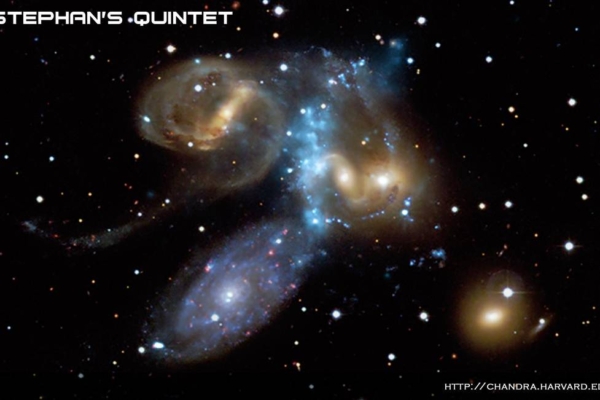Sixty top astronomical teams from the UK, France, Spain, and the Netherlands have observed, for the first time, two galaxies located approximately 290 million light-years away from Earth, through the Earth’s most powerful telescope system. These galaxies are positioned at the “cosmic crossroads” and are colliding with each other at a speed of 2 million miles per hour.
Using the cutting-edge William Herschel Telescope Enhanced Area Velocity Explorer (WEAVE) spectrometer, as well as the Netherlands’ low-frequency (144 MHz) array radio telescope (LOFAR), researchers observed the collision. They also confirmed the results using some data files from NASA’s Webb Space Telescope.
Within the Stephan Quintet (SQ) galaxy cluster, they observed the NGC 7318b galaxy colliding at a speed of 2 million miles per hour (about 3.2 million kilometers per hour) towards the NGC 7318a galaxy under the strong gravitational influence of the latter. The collision between the two galaxies generated a massive shockwave, similar to the sonic boom produced by a jet flying at supersonic speeds. This indicates that the collision speed of the NGC 7318b galaxy is 800 times faster than the flight speed of the Lockheed SR-71 Blackbird jet (approximately 2,500 times the speed of sound).
The Stephan Quintet galaxy cluster is mainly composed of five nearby galaxy groups, namely NGC 7317, NGC 7318a, NGC 7318b, NGC 7319, and NGC 7320. The Stephan Quintet was first observed in 1877 and gained worldwide fame for its appearance in the opening scenes of the 1946 Christmas movie “It’s a Wonderful Life,” symbolizing an angelic image.
Astronomers suggest that the collision between the two galaxies is likely due to the NGC 7318b galaxy being attracted by the total mass of other galaxies, causing it to fall into the NGC 7318a galaxy group. Considering the velocities and sizes at which they collide, the collision time may last about ten thousand years. The light from these galaxies takes around 285 million years to reach Earth, so what we see today actually occurred 285 million years ago.
The high-speed collision has severely damaged the NGC 7318b galaxy, causing a significant loss of its original hydrogen reserves. As the hydrogen reserves decline, the rate of new star formation within the NGC 7318b galaxy may decrease, as these stars primarily fuel on hydrogen atoms. Additionally, the energy released from this collision is sufficient to strip electrons from neutral hydrogen atoms.
Researchers also observed that the collision region showed an inverse correlation with the highest dust extinction regions. If dust can survive in the shock wave, the region would be a densely populated area with many dust particles, as materials in low-density environments may have been destroyed.
They believe that these observations could help unveil how galaxies like the Milky Way formed through long-term mergers and collisions.
Dr. Marina Arnaudova, Chief Researcher at the University of Hertfordshire in the UK, stated, “Since its discovery in 1877, the Stephan Quintet has represented a cosmic crossroads where fragments left by past galaxy collisions are observed.”
“Now, the NGC 7318b galaxy has rekindled this crossroads by impacting the region at speeds exceeding 3.2 million kilometers per hour, resulting in a powerful shockwave resembling that of a jet fighter,” she said.
Moreover, this observation has revealed a duality behind the so-called shock wave front that was previously unobserved, presenting uncharted territory for astronomers.
Dr. Arnaudova explained that the dual nature occurs when a shock wave passes through cold gas, propagating at a supersonic speed of 980,000 kilometers per hour (approximately 440 kilometers per second), several times the speed of sound in the Stephan Quintet interstellar medium. “This immense force can now tear apart atoms, allowing electrons to escape and leaving behind a luminous charged trail.”
Doctoral student Soumyadeep Das from the University of Hertfordshire noted that as the shock wave passes through surrounding hot gases, its speed decreases significantly, and its destructive power is weakened. “After the shock wave is attenuated, it does not cause major damage but compresses the hot gas, ultimately producing radio waves received by radio telescopes like the Dutch LOFAR.”
Professor Gavin Dalton, the Chief Researcher of WEAVE at RAL Space in the UK and the University of Oxford, stated, “Through WEAVE, we observe the impact within the Stephan Quintet. Besides unraveling the details of the ongoing collision, we have glimpsed the evolution and formation of faint galaxies within our observational range from a unique perspective.”
This observational achievement was published in the November issue of the Royal Astronomical Society Monthly Notices in the UK and has now been covered by 22 technology-related media outlets.

